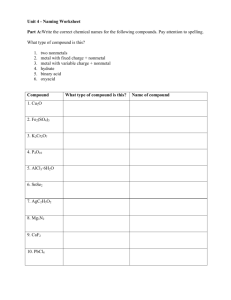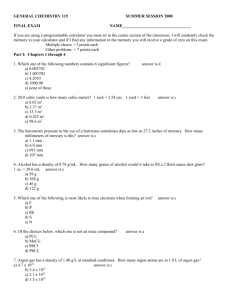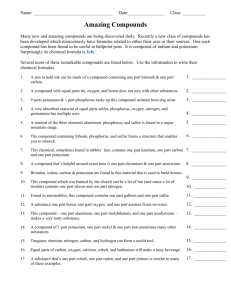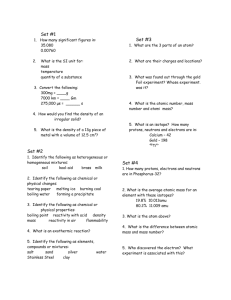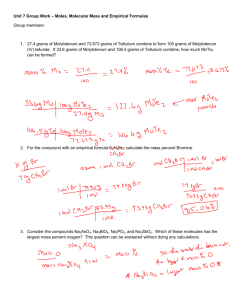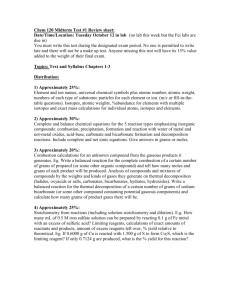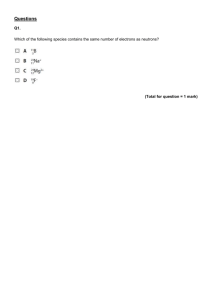SOL Strands 1
advertisement
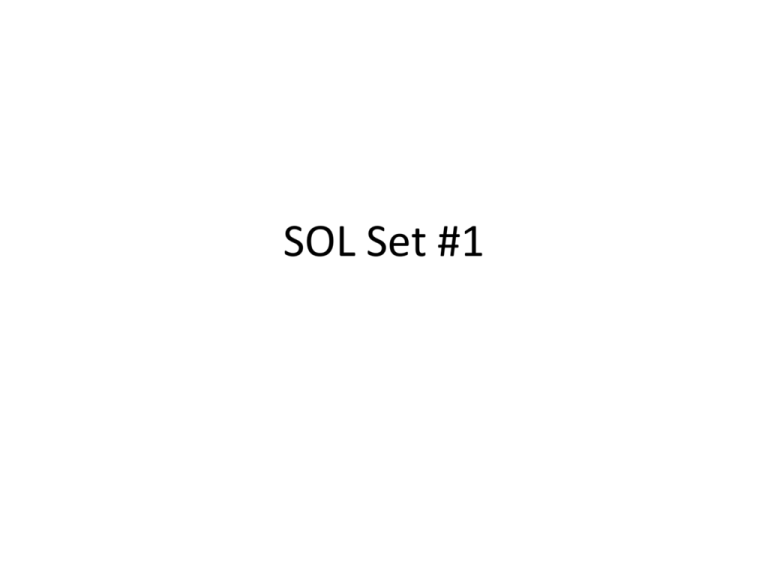
SOL Set #1 1. When ionic compounds are named, the name of a monatomic anion will end in which of the following suffixes? A -ic B -ite C -ate D -ide 2. What is the name of the compound with the formula PCl5? A Phosphorus(I) chloride B Phosphorus(V) chlorine C Phosphorus pentachlorate D Phosphorus pentachloride 3. Which of the following is the correct Lewis electron-dot diagram for the sodium atom? 4. How many electrons does the iron ion have when it forms the ionic compound FeCl3? F 20 G 23 H 26 J 29 5. When an electric current is passed through water, the reaction shown takes place. If the arrow were pointing in the opposite direction, what type of reaction would the new reaction represent? A Single-replacement B Double-replacement C Synthesis D Decomposition 6. Which of the following is a chemical change? F Salt is dissolved in water. G Water is boiled on a stove. H Gasoline combusts in an engine. J Copper metal is stretched into a long wire. 7. The diagram shows water molecules in an open beaker and water molecules that have evaporated into the air above the beaker. Which change in this system will increase the rate of evaporation? A Adding salt to the water B Increasing the temperature of the water C Increasing the pressure of the air above the water D Increasing the humidity of the air above the water 8. Based on its position in the periodic table, the element sulfur would be expected to have how many valence electrons? F4 G6 H8 J 16 9. Which is the best use for a fume hood? A Storing glassware B Removing toxic vapors C Covering volatile compounds D Mixing chemicals that release O2 10. If the temperature changes from point M to point N, at constant pressure, compound X undergoes -F one phase change G two phase changes H three phase changes J no change in phase SOL Set #2 1. Covalent bonds mainly occur between — A two nonmetallic elements B two metallic elements C one metallic element and one nonmetallic element D one metalloid and one metallic element 2. An example of a chemical property is — F mass of a substance per unit volume G ability to dissolve in solution H point where solid becomes liquid J tendency to undergo oxidation 3. A student hypothesizes that bromine (Br) has different chemical properties from krypton (Kr). The periodic table supports this hypothesis by indicating that — A bromine is a metal while krypton is a nonmetal B one mole of bromine is heavier than one mole of krypton C bromine and krypton are members of the same family D bromine and krypton have different numbers of valence electrons 4. A student determined that the density of a sample of tin is 8.00 g/mL, when the actual density of tin is 7.28 g/mL. What was the percent error in the student’s calculation? F 0.72% G 9.0% H 9.9% J 91% 5. Potassium (K) has a smaller atomic mass than argon (Ar) even though the atomic number of potassium is larger than the atomic number of argon. Which of the following best accounts for this observation? A) At STP, potassium is in the solid phase, but argon is a gas. B) It is easier for a potassium atom to lose an electron than it is for an argon atom. C) The most common isotopes of argon have more protons than the most common isotopes of potassium. D) The most common isotopes of potassium have fewer neutrons than the most common isotopes of argon. 6. Students want to separate and compare the components of black ink and green ink. Which technique is the best for the students to use? A chromatography B decanting C filtration D evaporation 7. What type of reaction is shown? A Precipitation B Neutralization C Single replacement D Double replacement 8. A student attempts to measure the specific heat capacity of an unknown liquid 𝐉 through repeated trials. She measures its specific heat capacity, in 𝐠 ∗ °𝐂 , as 2.14, 2.11, 2.13, 2.12, and 2.11. The specific heat capacity of the liquid should be recorded as — 𝐉 F) 2 𝐠 ∗ °𝐂 𝐉 G) 2.1 𝐠 ∗ °𝐂 𝐉 H) 2.12 𝐠 ∗ °𝐂 𝐉 J) 2.122 𝐠 ∗ °𝐂 9. What is the name for the compound CaSO4? A Calcium sulfate B Calcium sulfide C Calcium sulfur oxide D Calcium sulfur oxygen 10. When 1 g of sodium chloride (NaCl) is placed in 100 g of water, a solution results. Once the solution is prepared, water is now considered what part of the solution? F Solid G Liquid H Solute J Solvent SOL Set #3 1. The coefficients necessary to balance the equation correctly are – A) B) C) D) a = 2, b = 1, c = 1, d = 2 a = 1, b = 2, c = 1, d = 2 a = 1, b = 1, c = 1, d= 1 a = 2, b = 2, c = 1, d = 1 2. Iodine-131 is a radioactive isotope with a half-life of 8 days. How many grams of a 64 g sample of iodine-131 will remain at the end of 24 days? A) B) C) D) 56 g 48 g 32 g 8g 3. The reaction for the decomposition of ammonia (NH3) can be written as shown. If a student starts with 21.7 g of NH3 how many grams of hydrogen (H2) gas will be produced by the reaction? A 1.28 g B 2.55 g C 3.85 g D 32.5 g 4. What is the volume occupied by 51.0 g of ammonia (NH3) gas at STP? F 0.439 L G 22.8 L H 67.2 L J 91.9 L 5. When 80 g of sodium hydroxide, NaOH, are dissolved in enough water to make 500 mL of solution, the molarity of the solution is — A1M B2M C4M D8M 6. If the pH of a solution is 4, what is the pOH? F0 G6 H7 J 10 7. What is the empirical formula of the compound with the molecular formula C6H12? A CH C CH4 B CH2 D C2H6 8. Which of these is most likely to form between elements transferring electrons to form oppositely charged particles? F A metallic bond G A hydrogen bond H A covalent bond J An ionic bond 9. The table shows the specific heat capacity of four substances. For an equal mass of each substance, which one will require the least amount of heat to raise its temperature from 20°C to 30°C? A) B) C) D) Aluminum Glass Carbon dioxide Water 10. Which graph best shows the relationship between the volume of a gas and its temperature as the gas pressure remains constant? SOL Set #4 1. If 1.0 mole of methane reacts with oxygen to produce carbon dioxide and water, what mass of water is produced? A 16 grams B 18 grams C 36 grams D 44 grams 2. The number of molecules in 48.0 grams of oxygen gas is — F 6.02 × 1023 G 9.03 × 1023 H 1.20 × 1024 J 1.81 × 1024 3. What are the coefficients of the correctly balanced equation? A 1, 3, 2, 3 B 0, 2, 2, 3 C 1, 2, 2, 2 D 2, 6, 4, 3 4. A chemist is examining an unidentified element sample with oxidation states of +2, +3, and +6. The element has a shielding effect similar to that of potassium (K). Which statement about the unidentified element is most likely true? F It has the same number of neutrons as potassium. G It is a transition metal from the same period as potassium. H It is one of the heaviest elements in potassium’s group. J It is a mix of three unstable isotopes of potassium. 5. A) B) C) D) One example of an ionic compound is — F2 CO2 HBr MgCl2 6. Hydrogen chloride is a covalent compound. Which is a correct Lewis dot structure for HCl? 7. Le Chatelier’s principle describes what happens to a system in equilibrium when a stress occurs. All of the following could shift an equilibrium EXCEPT — A changing the pressure on the system B changing the temperature of the system C changing the identity of the catalyst D changing the concentration of one of the components 8. A mixture of gases with a pressure of 800 mm Hg contains 10% oxygen and 90% nitrogen by volume. What is the partial pressure of the oxygen gas in the mixture? F 10 mm Hg G 80 mm Hg H 700 mm Hg J 800 mm Hg 9. The specific heat of aluminum is 0.900 J/g ·°C. How much heat is required to raise the temperature of a 30.0 g block of aluminum from 25.0°C to 75.0°C. A 0.540 J B 1.50 J C 1350 J D 1670 J 10. What is the volume of the water in this graduated cylinder? F 4.39 mL G 4.41 mL H 4.55 mL J 5.61 mL SOL Set #5 The last ONE
